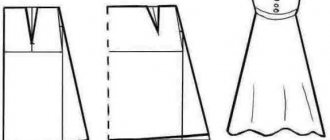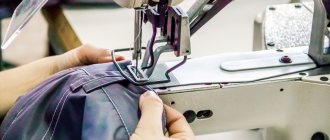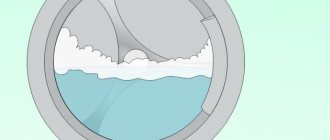Due to certain circumstances, women's wardrobes very often contain things that do not fit the figure very well. And there are a great many reasons for this, from banal fluctuations in body weight to purchases on sales during seasonal discounts. Of course, if your favorite skirt has become too small, then the problem takes on the scale of a planetary catastrophe. But if, on the contrary, it turns out to be too big, then it is enough to just sew the skirt up, laying a few machine lines in new places.
We'll tell you how to do this work yourself.
How do you know if a dress is too big?
You should also pay attention to the following 4 parameters: waistline, shoulder seams, darts and armholes. The shoulder seams on a well-fitting item will end just below the shoulder joint. If it happens lower, the thing is too big and will not fit in the shoulders. If it’s higher, it’s too small, and the sleeves will constantly “run” up.
Interesting materials:
How to disable the Ban on mobile payments service? How to disable video playback in Odnoklassniki? How to disable sticky Shift key? How do I disable protection in Microsoft Security Essentials? How to turn off the sound of the on-screen keyboard in Windows 10? How to turn off the sound when pressing keys on Huawei? How to turn off the sound when pressing keys? How to mute the sound in a WhatsApp group? How to unscrew a hex bolt with broken edges? How to open Android via computer?
How to sew a skirt at the waist
There are many ways to sew a skirt. Some of them require basic design knowledge, while others simply need to know how to use a sewing machine. However, before you give preference to one of them, you should decide on several important points.
- How many sizes does the product need to be reduced by?
- In what places does modification need to be done?
- What features are typical for the cut of an existing skirt?
To do this, just put on a skirt and look carefully in the mirror.
If you need to sew in a waist size of 1-size, then the whole process will not take much time and will turn into a pleasant pastime.
Reworking the product
In cases where the skirt fits perfectly on the hips and dangles in the waistband, the excess can be removed by increasing the depth of the darts . To do this you will need to work with the product.
Beginning of work
- Put on a skirt and carefully measure how many extra centimeters you need to remove
- Flog the belt or facing.
- Open up existing darts.
- Iron the product.
- Calculate the depth of new darts. In order not to delve into the nuances of design, it is enough to evenly distribute the existing surplus into 4 darts: 2 rear and 2 front.
Calculation of dart depth
If you need to sew in a skirt at the waist by 10 cm, then the calculation looks like this: 10 cm: 4 darts = 2.5 cm.
Important! Since the dart is an isosceles triangle, you should add 1.25 cm, the second half will be laid symmetrically.
This action, which at first glance seems absolutely uncomplicated, should be approached with the utmost care. After all, even a slight distortion of a few millimeters will be clearly visible on the finished product.
Continued work
- Mark the darts using a well-sharpened tailor's chalk or fabric marker. Please note that new darts are laid in the same place .
- Baste darts.
- Put on a skirt to make sure everything is done correctly. If minor defects are discovered during fitting, correct them.
- Sew machine stitches, not forgetting to make bartacks on each side.
Advice. To make the darts as neat as possible, the lines should be laid from the solution to the base.
- Iron darts towards the center . They must look at each other.
- Shorten the belt or facing by the same number of centimeters as you removed in the darts.
Note! The belt has an arched shape, repeating the line of the upper cut of the skirt. Therefore, excess should be removed symmetrically on both sides.
- Baste the details of the belt or facing, and then stitch on the sewing machine.
- Iron the seam.
- Baste the waistband/facing.
- Machine stitch.
- Press the seam well.
Reducing volume without tearing
This method is an ideal solution when a skirt needs to be sewn up 1–1.5 sizes in the waistband. As in all other cases, work on altering a product begins with a fitting, during which it is determined exactly how much should be removed from the waist.
With this method, all that needs to be done is limited to two actions:
- draw a new seam line on the product;
- grind.
Important! Depending on the style, excess fabric is removed in one seam (if it is located in the center of the back) or in 2 seams (if they are located on the sides).
If the skirt has a belt, then you can lay the seams on top of it. The main thing is to combine the top and bottom lines so that there are no distortions that significantly spoil the appearance of the clothes. But if the style provides for facing, then it is much better, neater and more beautiful to do the work as follows.
- Trim the facing (without cutting).
- Fold it up so it looks like a continuation of the product.
- Iron.
- Draw a line for the new seam.
- Sweep, try on.
- Sew on a sewing machine.
- Cut off allowances (process if necessary).
- Iron again.
- Secure the facing.
How to sew a circle skirt at the waist
In cases where you need to reduce the waist of a circle/semi-circle skirt, this can also be done in two ways:
- without ripping;
- without ripping.
In the first case, you will not need to perform any sewing manipulations; just insert an elastic band into the belt.
But in the second, the following actions will be required.
- Undo the belt.
- Reduce it by N number of centimeters.
- Gather the top section of the skirt.
- Baste the belt.
- Machine stitch and iron.
The easiest way
The simplest and easiest way to gather the top section of a skirt is as follows.
- Set the machine to the maximum stitch length.
- Sew along the top edge, 0.5–1 cm from the edge.
- Carefully tighten the threads. The assemblies form on their own; all that remains is to distribute them evenly throughout the cut.
Important! The thread needs to be pulled out exactly as many centimeters as you want to reduce the volume at the waist.
Agreement for the processing of personal data
Hereby, in accordance with Federal Law No. 152-FZ “On Personal Data” dated July 27, 2006, you confirm your consent to the processing of IP Dunaev N.A. personal data: collection, systematization, accumulation, storage, clarification (updating, changing), use, transfer solely for the purpose of collecting and transferring goods to you in your name. IP Dunaev N.A. guarantees the confidentiality of the information we receive. The processing of personal data is carried out for the purpose of effective execution of orders, contracts and other obligations accepted by IP Dunaev N.A. as binding upon you.
It is hereby specifically stipulated that you consent to the transfer of your personal data to transport companies, Russian Post or another organization through which Dunaev N.A. sends your order.
This consent applies to the following personal data: last name, first name and patronymic, email address, registration address, postal address for delivery of orders, contact phone number, payment details.
Ways to widen a small skirt
At the moment, there are several ways to widen a tight skirt, which, for example, has “risen” at the waist; they are considered the most effective and simple. These include the following methods:
- The pencil model can be enlarged by inserting it into the upper part of the side seams and on the waistband. It is better to make inserts in the form of a trapezoidal or rounded entrance to the pocket. Wedges are inappropriate here.
- To increase the size of a pencil skirt at the waist and hips at the same time, you need to make inserts from the waistband along the entire length to the very bottom. You can also use a detachable zipper as an insert - it is simply sewn into the side or middle seam.
- To increase the product by a couple of sizes, it is enough to make an insert at the front from a different material, due to which the canvas itself will expand.
- A straight model can be converted into a wrap skirt; to do this, you need to insert an expanding part made of a different material.
- It's even easier to widen a flared skirt - just cut it off at the top. Only in this case it is necessary to take into account that the clothes will become much shorter.
We will talk later about which modification option is suitable for specific purposes, because first we need to consider no less important nuances.
The process of expanding a small skirt has certain conditions:
- If there is no material left in the allowances, then the product will not be altered.
- It is better to refuse expansion if the skirt is different in color from the allowances. This often happens when things fade in the sun or fade during washing.
- It is better not to alter items made from thin fabrics, since holes from old seams are too visible on them.
Cosmo recommends
Fashionable haircut 2020 for thin hair - long bob: styling methods
Gel polish won't stick! What other procedures cannot be done during menstruation?
Have you lost weight or rushed to buy a skirt and it turned out to be too big at home? There are several ways to fit an item to your figure without resorting to the services of an atelier.
Things you shouldn't do to your skin
There are several prohibitions in the rules for caring for leather products:
- Do not store clothes in a bag where air does not circulate. In the closet, the skirt should hang, not lie. It is advisable to cover the product with a cotton cloth, which will protect it from dust.
- It is prohibited to use degreasers to remove dirt. Any substance that is used for the first time should be tested on the back of the lining or seams.
- In damp and rainy weather, wearing a leather skirt is not recommended. High humidity can cause it to stretch.
- During the washing process, do not rub the material, twist or stretch it.
Knowing how to properly wash, iron and store leather clothing will help keep your favorite clothes in good condition. A leather skirt can last from 7 to 10 years if you care for it following all the recommendations.
How to make things bigger - widen your pants
If you need to stretch them a little, then use water. To do this, take a spray bottle and pour water into it. But first, put the film on the floor, then lay the jeans on top. Apply water here and start stretching your jeans.
If you need to enlarge your trousers even more, then pour water into the bath. Now try to put on jeans. This is easiest to do if you lie down and then button your pants. Now, in this form, lie down in a bath of water and stay there for 10 minutes. Now you need to stand up and try to squeeze out the water directly on yourself.
Step out of the bath onto a shot cloth that is non-slip. You can use a rubber mat. After this, you will need to do gymnastics. Do the exercises. Squats will especially help.
After half an hour, you can take off your trousers and dry them.
If the method does not suit you, then take a special expander. First, also wet the fabric, then insert such a device here and begin to twist its mechanism to widen the trousers. You can take a special steamer or an iron with this function. When the pants become warm, put them on immediately and wear them for an hour to stretch them.
There are also more popular methods. To make jeans larger, turn them inside out and open the side seams. If there is enough allowance here, then create new seams and thereby make the trousers larger.
To make the trousers larger, you can insert stripes. Choose the right fabric. Now open the side outer seam. You also need to make a slot in the belt at this level. On the other side of the trousers, do exactly the same manipulation.
Now determine how wide the inserts should be. To do this, you can put on trousers, take a centimeter and see how much you need to add on each side. Now cut a ribbon of this width from a suitable fabric. Leave 7cm on each side for seams. Cut out the stripes. You can first baste them on your jeans. Then you can try it on and see if the calculations are correct. If the trousers still turn out to be too small or too big, then you will reduce the excess and sew on a machine. You won't have to buy new pants because you were able to enlarge the old ones.
And if the jeans are too small only at the waist, then watch the next master class with step-by-step photos. Take a suitable fabric. If you haven’t found one, you can rip off a piece of linen at the bottom of your pocket. To then make a pocket again, spread this blank along the seams. Now it consists of 2 parts. Place each on a suitable fabric and cut out. Make small allowances at the top. You will then stitch this pocket and sew it in place.
And the one you chose will be useful to you in order to increase the waist of your trousers. After all, this fabric is the same as on them. Carefully cut through the side of the belt on one side and the other. Now put your pants on yourself. Place a piece of paper or newspaper inside, draw with a pencil the place where you will need to cut.
Now take this paper pattern, attach it to the fabric folded in half and outline it, then cut it out.
Or you can first cut out a diamond-shaped wedge based on this blank. Then you attach it to the jeans, pin it, then lower the other half so that you get a double patch. It will be denser than a single one.
You can also make your jeans bigger in another way if you need to make them larger at the waist. This option is suitable for those who have gained a little weight and for young women who are expecting a child.
Methods of suturing
You can make your jeans fashionable and fit them to your figure yourself. Having carefully studied all the possible ways to sew in jeans and selected the right tool, you can get to work.
On the sides
You can quickly and efficiently sew jeans along the side seams by following a certain algorithm of actions:
- Turn the trousers inside out, put them on, and pin the places that need to be sewn together. Don't forget to leave a few centimeters of fabric for seam allowance;
- Take off your jeans and draw a seam line with chalk along the pins. Baste with thread. Craftsmen recommend trying on trousers with basting again so that, if necessary, you can adjust the seam line;
- we sew the basting or sew it by hand;
- trying on jeans again. If there is no feeling of constraint, the trousers fit perfectly in the hips, you can proceed to the final stage of work;
- We cut off the remaining fabric, not forgetting to leave a few centimeters for allowances;
- overcast or machine the edges of the denim and sew a second line.
When sewing jeans in the legs, the main thing is the correct measurements.
Turn the jeans inside out and put them on
We chop off in places where it is necessary to suture
At the waist
Those with an ideal thin waist and rounded hips are familiar with the problem of jeans that are wide at the waist. It's easy to solve. All you need is patience, needles and threads (or better yet, a sewing machine), and follow a clear algorithm of actions.
The first option for sewing jeans wide is simple:
- along the belt line we mark several darts;
- in the marked places, carefully rip off the belt (2-3 cm);
- sew the darts by hand or using a sewing machine;
- cut off excess denim fabric;
- sew on the belt.
The second method, how to sew jeans at home at the waist, requires more time, effort and patience:
- Carefully rip off the belt loop located in the center of the back of the belt. If a company label is sewn in this place, it is also removed;
- rip the belt ten centimeters to the right and left from the middle seam of the trousers;
- carefully rip out the crotch seam by eight centimeters;
- We iron all the torn areas thoroughly, remove excess threads;
- We fix the middle seam with pins (helps to avoid displacement of the fabric);
- we turn the two trouser legs inside out, place them on top of each other and draw a new seam line at a distance of two centimeters;
- we sew new markings, we process the edges by machine or by hand;
- turn the jeans outside and sew two central lines;
- We attach the belt to the jeans, trim off the excess fabric and stitch it;
- Additionally, we fasten the opened belt loop with pins and make a second line;
- The bottom edge of the product must be hemmed by hand or stitched on a machine.
Tapering to the bottom
You can taper jeans at the bottom using the technique of tapering the product on the sides, described earlier. But there is another way to sew jeans in the legs, allowing you to quickly and effortlessly get the desired result.
Before you begin, you need to prepare jeans that fit your figure perfectly. Pants that require adjustment are turned inside out and jeans of a narrower model are pinned onto them. Two pairs of trousers are pinned together, after which a new seam line can be marked. A seam is made using a machine or by hand (which is much longer and more difficult) according to the markings. The excess fabric of the trousers is cut off and the edges are overcast.
The technique of using a second pair of trousers in order to narrow the jeans towards the bottom helps to significantly reduce the time spent on fitting. If you need to narrow the bottom of several pairs of jeans, you can remove the pattern from the “correct” model and use it as a pattern.
Useful tips for sewing a skirt
- In sewing, 90% of success depends on taking measurements correctly. Therefore, never rush and remember to use the golden rule “Measure twice, cut once.”
- Even if you are in a hurry, do not neglect preliminary fittings. All defects are much easier to correct at the basting stage, and not after strong machine stitches with bartacks have been laid.
- Wet heat treatment (WHT) is one of the pillars of a quality sewn product. Make it a rule to always iron your seams, this is the only way you will achieve the perfect appearance.
- Even if the iron has a steam function, it is still better to iron the seams through thin, undyed cotton fabric or gauze.
What to wear with a brown skirt?
What to wear with a tulle skirt
Softening
Leather hardens after a while due to improper use or poor quality material. On the Internet, you can often come across articles where it is recommended to use coconut oil to soften the skin.
This is wrong advice. Coconut oil can affect the structure of the skin and change its color. In addition, it has a smell that is absorbed into the material and does not disappear for a long time.
The skirt must be lubricated with special products to moisturize real leather and its substitutes. These conditioning creams can be purchased at hardware stores. Before applying the product, the surface of the product must be cleaned of dust.
The conditioner is applied to the skin and left for 10-15 minutes. Then remove the remaining cream with a clean microfiber cloth. To prevent the skin from hardening, this procedure should be repeated every 6 months.
Such products should be used with caution. Some of them can slightly change the color of the skin if applied to areas with scuff marks. The material may become lighter in color at the site of damage.
Skin restoration and elimination of defects on the skirt
Sometimes the leather may crack and lose color in some areas that have been subject to frequent rubbing. Most often, leather deteriorates where there are pockets and belt loops. Sometimes the edge of the hem and the top of the waistband are worn out.
For minor scuffs and scratches, you can apply shoe polish in the same color as the product itself. This is a temporary solution. The cream will be washed off during the next wash.
The article describes in detail how you can smooth a leather skirt.
Before applying the abrasion masking agent, the skin should be treated with alcohol wipes. The cream must be applied very carefully, in small quantities. You can use cotton swabs. A thick layer of cream can dry out the damaged surface more, so the product needs to be blended well.
How to sew in the sides of a skirt
It is not always possible to sew a product to the desired size simply by increasing the depth of the darts or reducing it in the waistband. Sometimes adjustments have to be made along the entire length of the skirt. In this case, you can remove excess fabric from the sides.
Important! If you plan to reduce a skirt that has darts by 3-4 or more sizes, then in no case should you remove all the excess just by adjusting the allowances of the side seams.
It is better to transfer some of the excess to the darts so that they do not move significantly from the center to the sides. Otherwise, the altered item will not fit well and will look slightly ridiculous.
The work begins with fitting, during which they determine where the new seams will be placed. Of course, it’s good if at this stage of work you manage to find an assistant. But with some skill, you can cope on your own.
Completing of the work
- The excess is evenly distributed on 2 sides and pinned off with tailor's pins.
- Remove the skirt, turn it inside out and draw a dotted line at the chipped areas.
- Remove the pins.
- Check the symmetry of the drawn lines and adjust if necessary.
- Swept away.
- They try it on.
- If the village is ideal, then they grind it by car.
- Cut off the excess and process the seams.
- Ironing.
Rules for daily care of a leather skirt
What rules should you follow:
- Things hanging next to the skirt on hangers should not squeeze the leather product, otherwise it will become very wrinkled and then the material will be impossible to straighten.
- Hangers with clothespins and clips must not be used. They will leave dents on the skin that cannot be smoothed out.
- When purchasing a leather skirt, you should make sure that it fits the owner in size. Otherwise, the material will sag in some places, or, conversely, become very stretched. In this case, loss of product shape is guaranteed.
- Do not use substances containing chlorine, solvents or gasoline to remove stains.
These are general rules for caring for a leather skirt. However, it should be remembered that real and synthetic leather differ from each other in texture, so care for such clothing must be carried out, taking into account some nuances.
Made from genuine leather
Caring for a real leather skirt should be delicate.
Main rules:
- It is advisable to clean the skin of dirt and stains without contact with water.
- Washing is required only in special cases. Real leather must be washed by hand. Do not use a washing machine.
- It is not recommended to dry the skirt with a hairdryer, or hang it on the sunny side of the balcony.
Improper care can harm the skin. It will harden, crack and lose its attractive appearance.
PU Leather
Leatherette is less “demanding” to care for.
What rules should you follow:
- You can use a washing machine, provided that the temperature conditions are observed. The water should not be hotter than 25 °C.
- Occasionally you can dry it in a centrifuge.
- Stain removal solutions should not be applied directly to the surface of the skin. First, you need to soak a cotton pad or cotton napkin with them, and then try to remove the dirt.
Further in the article you can read the rules about caring for skirts made of artificial leather and natural materials in more detail.
Washing the skirt
Contaminated areas of skin can be cleaned without using water. There are several alternative dry cleaning methods. However, these methods are not always effective. In some cases, clothes have to be washed, so it is important to know how to do it correctly.
In the washing machine
Real leather cannot be washed in a machine, but synthetic leather can, if you remember 3 important nuances:
- washing should be quick;
- water should not be heated above 25 °C;
- You need to wash without powder, stain remover and fabric softener.
Increase in waist circumference
If the waist line needs to be increased by no more than 2 cm, add 1/4 of the required size to the side sections of the back and front panels and connect the new lines with the original ones at hip level. To increase the waist by a larger amount, reduce the bevel of the side seams and the width of the darts.
Lateral enlargement
Place a piece of paper under the edge of the pattern and secure it. In order to increase the waist circumference, measure the desired value from the edge of the pattern and mark it. From this mark, draw a new line, gradually bringing it to the starting line at the level of the hips (for a skirt) or chest (if it is a bodice). The same changes need to be made on both the front and rear.
Increase by darts
To increase the waist circumference of the darts, you need to reduce their width. Inside the dart, mark new lines and connect them to the starting point. Fold the dart and cut it from the top cut line. The distance between the new and original lines on both sides of the dart is the amount of increase in the waistline on this pattern piece.
Skirt on the hips
When increasing the waist by 2 cm, add 1/4 of the required size to the side sections of the back and front panels. With a larger increase, move the side seams and reduce the width of the darts.
Skirt with wedges
When the waist increases by up to 2 cm, additions are made only to the side sections. For a larger increase, divide the required amount equally between all seams except the middle seams of the back and front wedges.
Skirt sun"
To increase the waist circumference, lower the waistline so that the seam line (not the cut) drops 1/4 of the amount you need to change to increase the waist, not including seam allowances. The length of the skirt is added by allowing for the bottom hem line.
Trousers
Additions to the waist circumference of up to 2 cm are made only along the side seams. With a higher magnification, the required amount is distributed between the side seams, the middle seam and the darts. The side seams are changed symmetrically.
Dress
To increase the waist by more than 2 cm, reduce the width of all darts at the waist before adding seams.
Side dress
When increasing up to 2 cm, add 0.5 cm to the side sections at waist level. The new line merges with the original one in the chest and hips. At higher increases, 1/12 of the increase in waist circumference should be added to the side and curved seams.
kroykashite.ru
How to clean?
Some stains can be wiped off the skin with wet wipes. Contaminants that cannot be removed by this method are removed with vinegar, alcohol or soap solution. You can read about dry skin cleaning methods further in the article.
Wet wipes
What wipes are allowed to be used and what can be removed from the surfaces of leather items.
| Children's | They erase oil stains, lipstick marks and other decorative cosmetics well. |
| Antibacterial | Suitable for removing stains from soapy water. |
| Alcohol | They erase grease stains and remove traces of spilled wine. |
| Alcohol-free | Helps remove dust. |
Stains must be removed immediately. The longer a foreign substance is in contact with the material, the more strongly it will “eat” into its structure. Grease and oil stains are absorbed into the skin faster than any other contaminants. Therefore, when putting on a leather skirt, you should always take a pack of wet wipes with you.
Ammonia
Ammonia will help remove stubborn stains. In small quantities, it is unable to cause damage to the skin.
How to properly use ammonia to clean a skirt:
- Apply 3-4 drops of ammonia to a cotton pad.
- Lightly rub the contaminated area. You should make careful movements, erasing the stain from its edges, gradually moving towards the center.
- If the dirt is not completely removed the first time, the procedure must be repeated.
- Remove any remaining alcohol from the surface of the skin with wet wipes.
Before using ammonia, you need to open the windows in the room. Protective gloves should be worn on your hands.
Soap solution
Soap solutions should be prepared using soft substances, such as baby soap or shampoo. The main condition when preparing the solution is that it should not contain components containing chlorine and phosphates. For 1 liter of water, 1 tsp is enough. shampoo or 25 g of ground soap.
Ethanol
Ethyl alcohol effectively removes greasy stains. To remove dirt, alcohol should be applied to a cotton pad and gently rubbed onto the area of skin that needs to be cleaned.
This treatment helps to quickly degrease the stained area and remove the stain from its surface. When the dirt is removed, the cleaned area will need to be lubricated with lemon juice, then a thin layer of glycerin should be applied on top. These are preventive measures against cracking of the material.
Vinegar
Vinegar can be used to remove salt stains and remove stains that may form after washing. If the skirt is not rinsed well after washing, then during the drying process whitish spots (stripes in the form of stripes) appear on it.
A cotton napkin soaked in table vinegar will remove these stains. You need to wipe the pockets and side seams of the skirt with vinegar after washing to remove any remaining soap from the threads with which the skirt is sewn.
In the studio
The need to take a sundress or dress to a studio arises if you can’t do it yourself or don’t have a machine. It is also better to trust a specialist if the dress has a complex cut or needs to be changed by 3-4-5 sizes (then only a professional can recut it).
It is also important to remember that there are certain specifics when working with elastic fabrics. They can become pulled together or deformed when sewing and, in order not to spoil the product, it is better to trust the seamstress
If the dress has a complex pattern and many elements, then it will be difficult to reduce its size on your own. In this case, it is better to hand over the dress for a girl or woman to an atelier; experienced seamstresses will do it efficiently. Evaluate the rationality of your choice; this option is not always economically justified. It should be remembered that different fabrics used for sewing dresses have different quality characteristics, for example, linen and knitwear. They stretch and lay differently, this should be taken into account when remaking finished products.
How to make a skirt one size smaller/larger
Steaming a product in a water bath for several hours is an unsafe way to stretch leather clothing. It might go bad. A skirt can only be made a size larger in a studio. You can make suede inserts on the sides or sew elastic in the waistband area.
Also, in the studio, you can sew a skirt up to 1-2 sizes. The craftsman will trim off the excess material and carefully join the side seams. A skirt with an elastic band can be made smaller by opening the seam at the waistband, tucking in the elastic band and securing the bend with secure seams. Then you need to sew the belt again with a hidden seam.











